The path to a successful partnership between business and IT
Does it have to be the goal of IT to be perceived as a strategic partner or is it enough to position itself as a service provider within the company?
The answer first of all - no, the high differentiation requirements from the market for a company also require an active and formative role for IT in the company with discussions at eye level. This means that many IT departments need to redefine and reposition themselves. It is no longer enough to simply act as an "order taker" and be perceived within the company. Repositioning is a complex and time-consuming undertaking, as there are still major changes on the horizon due to digitalization, cloud transitions and AI innovations, which are demanding most of IT's resources and capacities.
But how do you make the transition from "order taker" to "strategic partner" in the current situation?
The solution is actually obvious - create trust in the business!
The good news is that creating a culture of trust is not necessarily extra work, but is built on consistent work such as:
- Do things the right way!
- Less is more!
- Make reliable statements!
- Align expectations!
- Continuous and open communication
- Having the courage to make decisions and taking responsibility for them
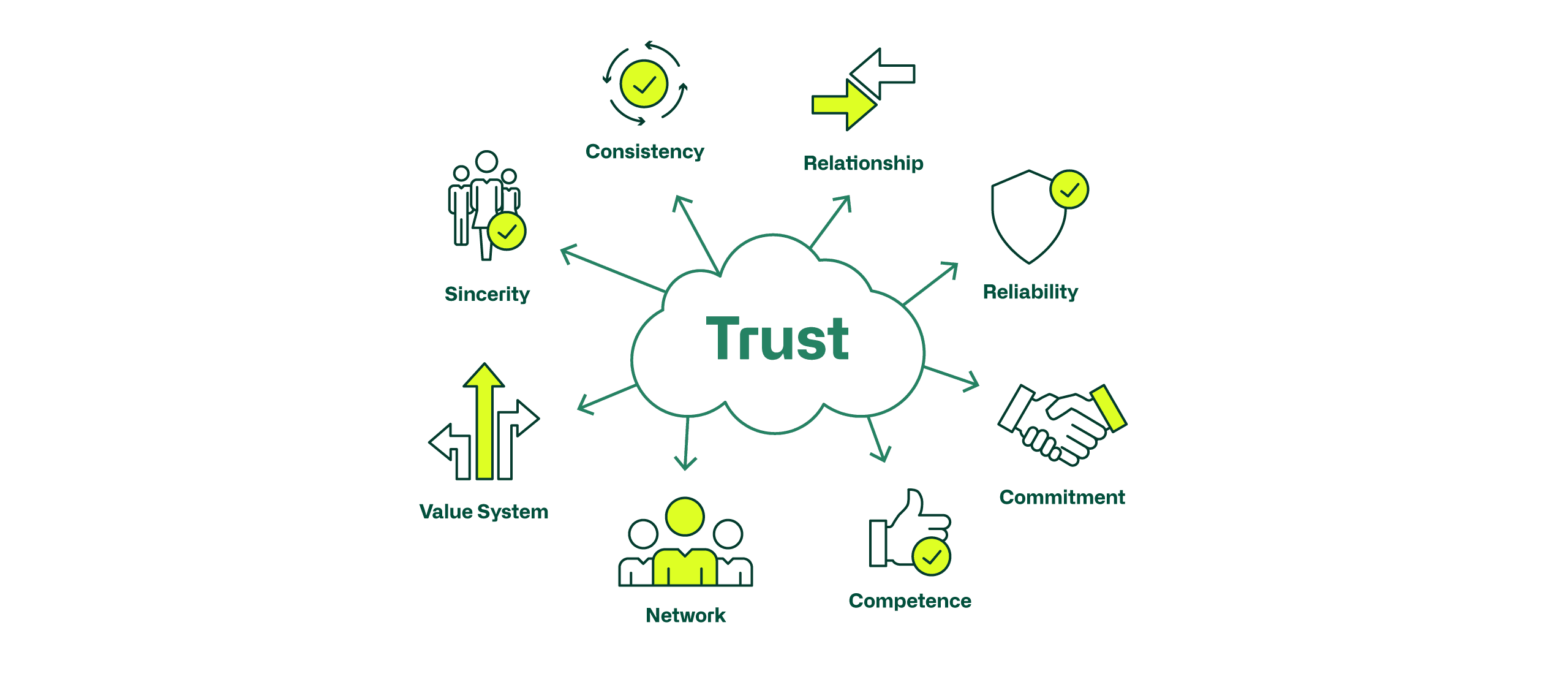
In our experience, the first step should be to focus on a selection of attributes that will create and strengthen the basis for mutual trust within the company.
The success of a company has long been dependent on functioning, efficient and effective IT services. The goals and successes must be jointly aligned with the company's success. The relationship and position of trust between the business and IT is crucial for joint success. This means a common strategy, goals, values and uniform management. Ultimately, successes and failures are shared. As partners, we are all in the same boat!
As long as corporate IT positions itself and sees itself as a service provider for the business, nothing will change in terms of the client vs. service provider hierarchy.
Experience shows that this is a process that requires a gradual approach and a rethink within the company.
"I personally like to compare this in the context of a mountain climber, who has the necessary expertise thanks to his training and corresponding practical experience. This competence enables him to bring his customers safely and securely up the mountain and back down again.
He has an eye for the important details, such as the weather, the nature of the route, the dangers and risks involved. He is aware of his responsibility for the whole group.
He has the necessary personality to meet them where they are and give them the feeling and security that the summit is an achievable goal.
In a company, business can be the mountain guide one day, and IT the next, but the important thing is that no matter what position you are in, mutual trust and respect for all parties play a crucial role"
Jessica Knecht, Consultant
What is a proven approach?
The Business Relationship Maturity Model can be used for various purposes, on the one hand to determine the maturity level of a company or to define a strategy for the future orientation of business and IT.
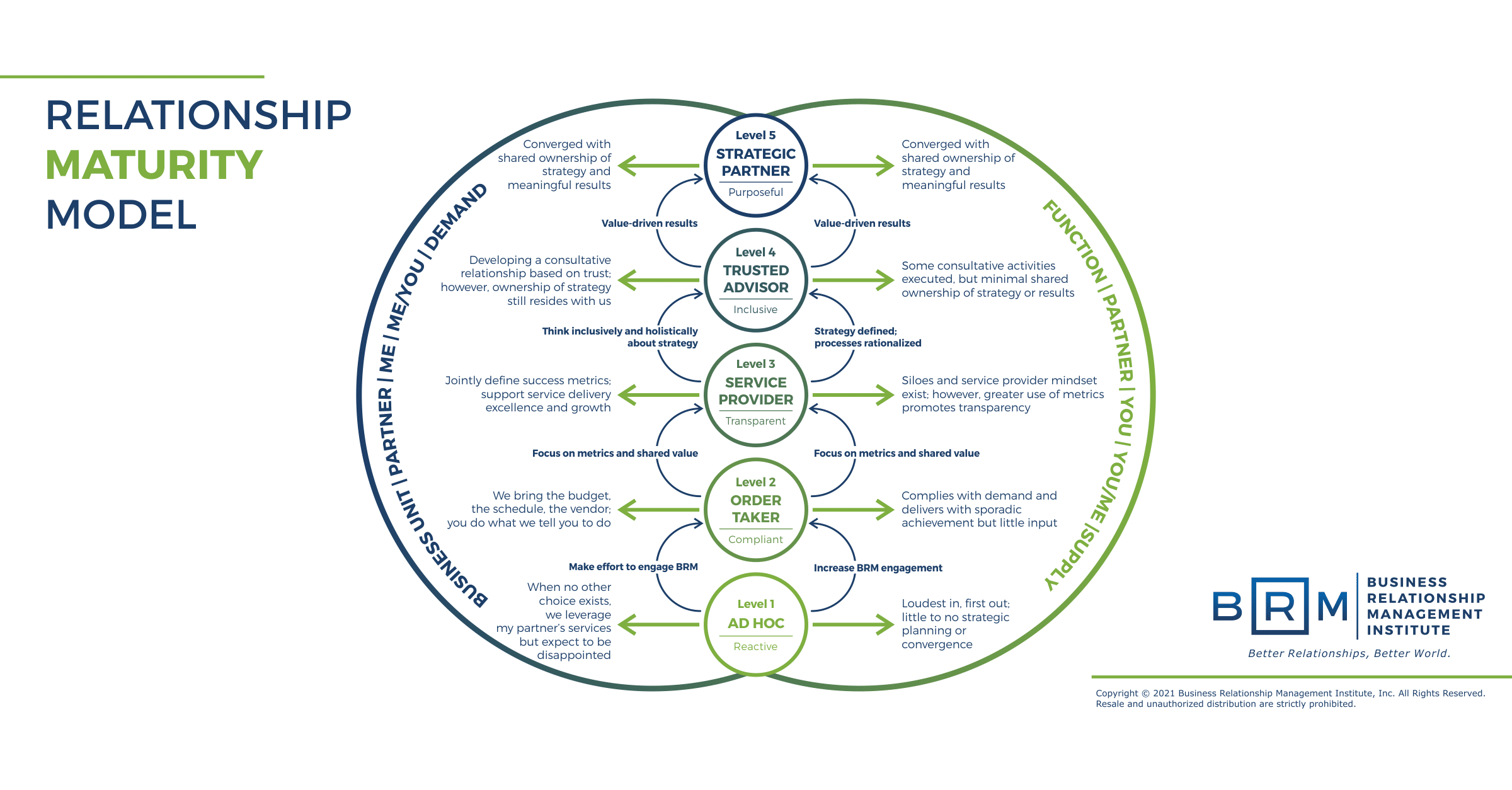
Level of the BRM model:
Level 1 - Ad Hoc:
At this stage of maturity, requests from the business are usually not approached and processed in a structured manner and therefore do not follow clear processes and structures.
Level 2 - Order Taker:
Requests are already being received and processed by the business in a more structured way, and work is underway to improve and prioritize important services.
Level 3 - Service Provider:
A routine creeps into the processing of services, there are fixed processes that are followed and a certain level of efficiency is already implemented, but innovation falls by the wayside. The costs are transparent, but the added value that is generated is still more of a subjective perception.
Level 4 - Trusted Advisor:
The processes are known and well implemented in the company. There is a mutual relationship of trust, the services are now aligned with the company's goals and a shared added value is achieved, which also means a willingness to make investments.
Level 5 - Strategic Partner:
Common goals, risks and quality standards are defined. The company's goals are tackled together and driven forward hand in hand; the "service provider" is now seen as an integral part of the company and an important decision-maker.
What is important in the methodology of the Business Relationship Maturity Model is that there is no predefined start and end point in the model; you start with one of the most important practices "Start where you are". The current maturity level of relationships and processes can be determined impartially by means of interviews, assessments and surveys.
Each level of BRM represents a certain degree of trust and collaboration, as well as the value and impact that this collaboration generates between the various stakeholders. The type of relationship - external or internal, operational or strategic - is irrelevant.
First, the criteria (feedback, communication, innovation, etc.) of the individual levels are defined, which forms the basis for evaluation.
This in turn forms the basis and starting point for all further steps, comparing the current level with the target level in order to implement and drive forward strategic improvement opportunities, of course always taking into account a timetable to measure the results at fixed intervals.
Conclusion
The question can now be asked, what level of maturity must be the main goal of the IT department nowadays, is it to be a strategic partner or is it not enough to simply be perceived as a trusted advisor?
It is undisputed that IT plays an essential role in every company, regardless of its maturity level, because digitalization, artificial intelligence or the cloud cannot be implemented without IT, and its contribution is therefore an essential part of the success of every company.
How can atrete help?
We help you to successfully implement your vision of a partnership between business and IT.
Our consultants have many years of expertise in the realization of corporate transformations. We are happy to bring the experience gained from our projects to you for the efficient and successful realization of your plans.
atrete further expands consultant team
In recent months, the renowned consulting firm atrete has added three new talented members to its team to strengthen its CIO Advisory, Digital Workplace and Cybersecurity divisions.



Jessica Knecht has been supporting the team in the CIO Advisory practice area as an Associate Consultant since April 1, 2023.
Ms. Knecht brings extensive experience in the IT sector, particularly in IT Service Management and Cloud Provider Management. Prior to joining atrete, she worked for several years as a Customer Service Manager at a renowned IT service provider. She holds a degree in Technical Business Administration and has completed a CAS in IT Sourcing and Provider Management at ZHAW. She is also certified in IT Service Management (ITIL Foundation), Requirements Engineering (IREB Foundation) and Microsoft Azure Fundamentals.
Vivien Bührer joined the Digital Workplace and Collaboration practice as a Consultant on June 1, 2023.
Ms. Bührer has an impressive career that includes time as a Solution Designer for End User Services at Fujitsu. In this role, she managed tenders for managed workplace services and advised on IT service management topics. She holds a Master of Science in Business Analytics, Controlling and Consulting and also brings qualifications such as Scrum Master, Hermes and ITIL certifications.
atrete warmly welcomes Sven Gerig, who has been supporting the Cybersecurity Practice Area as a Consultant since June 12, 2023.
Mr. Gerig can look back on a successful career with various IT service providers in the Zug region, where he worked as a project manager and systems engineer. His extensive knowledge is also reflected in his certifications, including Azure Solutions Architect Expert, Cybersecurity Architect Expert and Enterprise Administrator Expert in Microsoft. He also brings qualifications such as SAFe® Scrum Master and ITIL 4 Foundation. Soon he will complete his degree as dipl. Informatiker HF Fokus Cyber Security.
Media contact:
at rete ag
Marlene Haberer
Phone: +41 44 266 55 83
Email: marlene.haberer@atrete.ch
7 steps to an effective digitization strategy
A digitization strategy remains an important part of any business plan, especially in today's digital world. A well-thought-out digitization strategy can help increase the company's efficiency, productivity and profitability.
1. identification of the core processes
The first step in developing a digitization strategy is to identify the company's core processes. This includes the processes that are essential to the company's core business and have a direct impact on the company's profitability and success. Identifying these processes is a crucial step, as the digitization strategy should focus on optimizing and automating these processes. For this to succeed, it should be done in close coordination with the business.
2. analysis of the current IT systems
After identifying the core processes, an analysis of the current IT systems should be performed. This includes an assessment of the existing IT infrastructure, applications, databases and interfaces used for the company's core processes. This analysis helps identify weaknesses and bottlenecks in the current IT infrastructure and indicates which systems need to be optimized or replaced. Central systems that are required for several core processes and "customer facing" applications are to be prioritized.
3. definition of IT goals
After the analysis, clear IT goals should be defined that are aligned with the core processes. These goals should be specific, measurable, achievable, relevant and time-bound (SMART). Examples of IT goals may include reducing downtime (resilience!), improving data quality, automating processes, and increasing efficiency and productivity.
4. development of a digital transformation model
The goal of digital transformation is to improve efficiency and agility and create new business models that meet the changing needs of customers. This includes technologies such as cloud computing, artificial intelligence (AI), and data analytics to create new products and services that strengthen customer loyalty and improve operational processes.
The digital transformation model requires a redesign of business processes, customer relationships and organizational culture, which should be closely aligned with the identified core processes. The digital transformation model provides information about the direction in which the company wants to develop and is therefore central to the digitization strategy.
5. development of a digitization strategy
Based on the analysis of the current IT systems and with regard to the digital transformation model, a digitization strategy can now be developed. This strategy should be as precise and comprehensive as possible and include all the steps required to achieve the defined IT objectives. The digitization strategy should also take into account the expenditures for implementing the strategy and ensure that the expenditures are in line with the corporate objectives.
6. implementation of the digitization strategy
Once the digitization strategy has been developed, it is time to implement it. Implementation should be carried out step by step on the basis of the prioritization that has taken place and in close collaboration with the departments and employees concerned. It is important that the implementation of the digitization strategy is closely monitored to ensure that the defined IT goals are achieved. Implementation should also include training for employees and the introduction of new IT systems and processes, and may also require restructuring of the organization.
7. review and adaptation of the digitization strategy
Reviewing and adapting the digitization strategy is a continuous process. It is important to conduct regular reviews of the IT systems to ensure that they meet the company's requirements. Based on the results of these reviews, adjustments should be made to the digitization strategy to ensure that it is always aligned with the current needs of the business. At best, you should validate the digitization strategy annually.

Conclusion
A well-thought-out digitization strategy that is aligned with the company's digital transformation model can help to increase the company's efficiency, productivity and profitability. The above steps can serve as a guide for developing a digitization strategy.
However, it is important to note that the digitization strategy should not be viewed in isolation from other business strategies and should be closely aligned with corporate goals and strategies. Successful implementation of a digitization strategy also requires the full support and participation of all relevant departments and employees in the company.
If we have learned anything in the past months, it is that environmental influences can change. Therefore, the implementation should be gradual and it is important to continuously validate whether prioritization and the targeted goals are still up to date.
atrete is happy to support you in this process.
Challenge of agile service organizations
An agile organization is characterized by aligning its activities and goals with the value creation of the company. The focus is on customer orientation and alignment of all services with the customer experience.
Sure, this sounds good and right. But anyone who has ever been confronted with the task can confirm from experience that this can be a rocky and long road. This blog goes into some hurdles that we experience again and again in our projects.
What characterizes an agile service organization?
An agile service organization puts business results at the center. This is done by aligning all activities in the enterprise and developing appropriate capabilities in the organization that focus on services to achieve value for customers.
The agile organization consists of teams that combine a high degree of responsibility, competencies as well as expertise. These interdisciplinary teams consist of the necessary resources that support the service throughout the entire lifecycle. In order for these agile teams to work efficiently, the following framework conditions must be created:
- Focus on the services and their value chains with an appropriate roadmap
- Introduction of uniform governance structures and an agile framework for collaboration
- Understandable and flat structures. The number of teams can vary and depends on the requirements
- Shift of competencies from traditional management to agile teams and service owners respectively
- Introduction of agile principles such as iterative approach, empirical service control and establishment of a feedback culture in the organization
The entire organizational framework usually has to be redesigned in order to successfully transform the service organization. This concerns specifications, responsibilities, interfaces, technology adaptations, structures, etc. The core competencies required for the individual activities can be suitably described in the four dimensions of technology, processes, culture and organization.
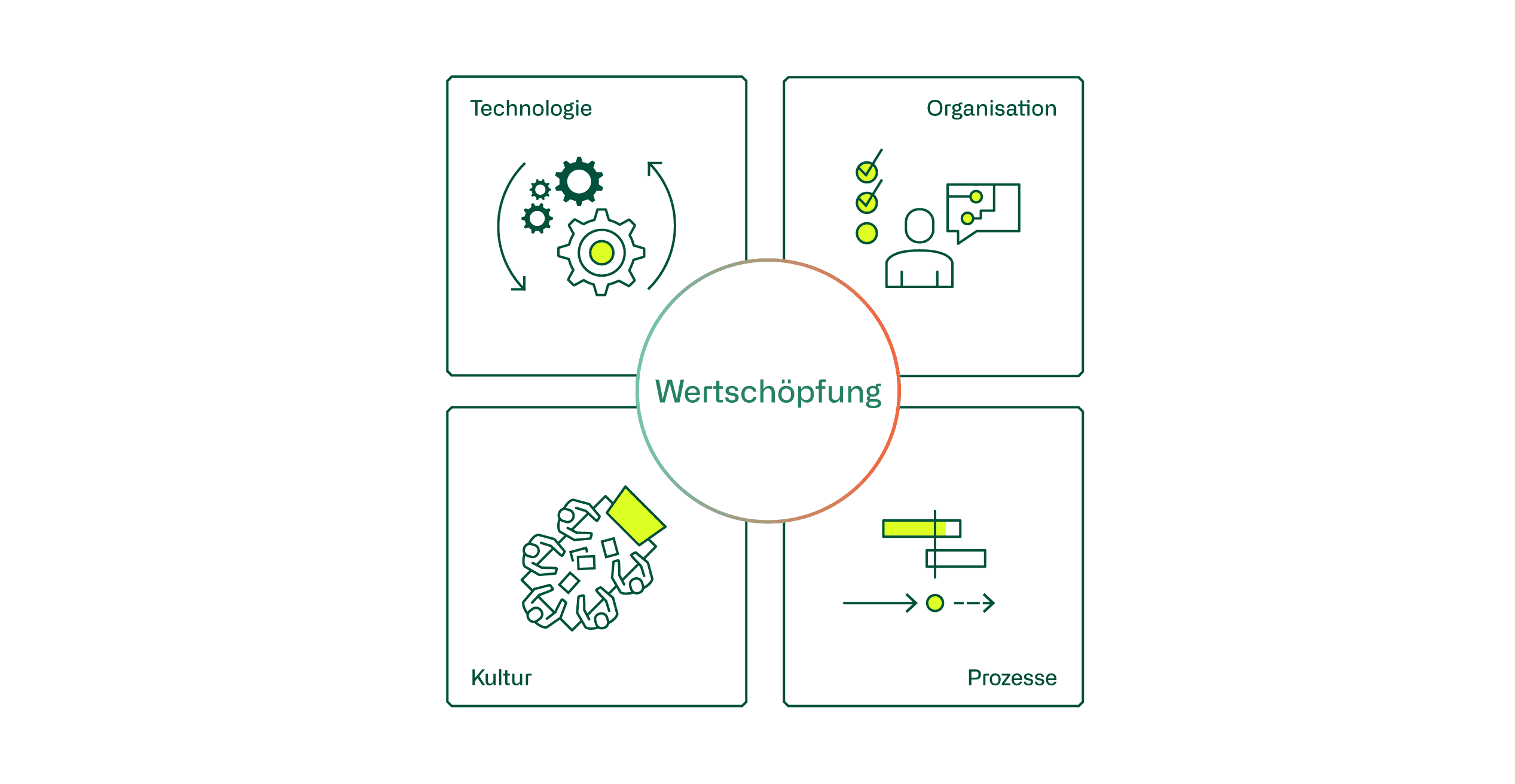
What are the challenges in practice?
Transforming a company with a hierarchical line organization into an agile, fully networked organization sounds very good in theory. But practice shows that transformation is a very big challenge that affects all four dimensions.
Technology
The use of new, mostly cloud-based solutions is not only the basis of digitization, but also demands and promotes agility in order to react quickly to changing requirements. Essential here are the creation of transparent structures and the automation of all repetitive activities. Indirectly, cloud technology also achieves a standardization of the platform. However, a greenfield approach is rarely possible and various challenges must be dealt with in reality:
- Migrating a legacy environment is complex, challenging and costly. This is not least due to the lack of harmonization and the rigid integration into the business environment.
- In many cases, the know-how for the grown, complex legacy environments is not available to a sufficient extent.
- The optimal starting point for platform transformation is not easy to find, or prioritization requirements shift the focus to other issues.
- The costs for cloud services are sometimes difficult to plan.
- Governance basics such as data classification, cloud strategy, security concepts are often missing.
Organization
An organization is defined by the way it performs tasks and achieves service goals. By means of newly formed work groups, a shift from rather rigid hierarchical structures to agile teams with the appropriate competencies is sought.
For companies that traditionally have a hierarchical organizational structure, the introduction of a purely agile organization becomes a major challenge. This is not least because very ambitious goals are usually set by management. In addition, the organization is also challenged a great deal in ensuring traditional operations and the parallel transformation of areas into the new agile organization. Typical questions and challenges during organizational transformation are:
- What is the appropriate strategy and governance for organizational transformation?
- How does the transformation of the service catalog including the supplier services into the agile further development have to take place?
- What is the impact of transformation on the mission and the new roles/teams responsible, without losing focus on service value creation?
- There is a tendency for key people to be assigned to too many teams, negatively impacting their productivity.
- In the composition of the teams, too little conscious attention is often paid to filling suitable people with the new roles. This often has a negative impact on the efficiency and effectiveness of the teams.
Culture
Corporate culture is shaped by values and behavior. The environment can be divided into three groupings:
- The leadership team (management), which should exemplify its own guidelines (walk the talk)
- The individual team, which is as strong as the weakest link.
- Each team member with individual preferences as well as strengths and weaknesses
Agile organization theory states that cultural changes lead through all organizational levels. In an agile organization, the manager is supposed to lead less, but instead show more of the framework and prepare the working bases, the teams are given more responsibility and a team member is given more competencies. Since people fundamentally desire stability, this leads to a potential contradiction in the agile approach.
- How do you communicate the new values to create perspective and security in a rapidly changing environment?
- How are employees to be empowered in dealing with the new responsibility?
- How do employees cope with the new open management style?
- Decisions must be made and supported by the team.
- The classic manager, who acted as a hierarchical decision-maker for many years, must adopt a new management style as a service enabler.
Processes / Structure
The orientation of the necessary processes is geared towards supporting the value streams. This makes different characteristics possible. The processes must individually reflect the value streams and the agile way of working. How many and which processes are needed in an organization so that it functions autonomously cannot be answered simply like that. The processes and the process landscape should adapt to the teams and their methodologies that they use. It is important that the processes and interactions are mapped into an adequate IT Service Management (ITSM) or Enterprise Service Management (ESM) tool to manage process fidelity. We see further challenges in process mapping in the following areas:
- There is no service catalog and thus there are different goals or expectations for the processes.
- The perception of service matriculation varies across teams.
- Basics such as specifications, connections, dependencies and interfaces between the remaining hierarchical organizational units and the new agile teams are missing.
- The conversion of the processes is very complex due to various dependencies and the need for parallel use in the old and new value creation.
Conclusion
Transforming an entire business organization takes time and the necessary patience. There is no blueprint for rapid implementation. The change to an agile organization should primarily be characterized by optimizations and adjustments to the value chains and thus the service portfolio. The appropriate and necessary agility of the service organization is predominantly based on the flexible composition of the required teams and their activities. Employees are a very important part of the organization and should be involved in the organizational transformation accordingly at an early stage. A new organization should be introduced in small steps with the inclusion of processes, structures and technologies. Traditional organizations and corporate cultures can only be changed over a longer period of time. For rapid success, a hybrid organizational approach can help. This means that existing and proven service models are compatible with new agile approaches in the organization. With such a hybrid organization, the transformation can be simplified and implemented according to requirements.
Does every organization now have to adopt agile?
We see this as similar to other market trends, e.g., the cloud. At some point, there will be no way around it, because the world is developing in this direction and enough advantages will arise from it. Each company must decide for itself what form an agile service organization should take and in what timeframe it should be introduced.
How can atrete help?
The atrete consultants have the expertise for successful transformation projects from countless customer projects, be it a SAFe introduction, a DevOps implementation, a technological cloud transformation or an ITSM/ESM further development.
IT service catalogue as a mirror of the IT organisation
The effect and benefit of a meaningful IT service catalogue is still underestimated today. There is no better control instrument than a coordinated IT service offer that covers the requirements and expectations of the customers and service recipients. The effect that a good IT service catalogue has on the customer is essential for successful and constructive cooperation.
An excellent example of the selection and consumption of services is gastronomy. After entering the restaurant, one is led to the table and shortly afterwards is handed a menu card. This contains an assorted selection of food and drink options. The entire offer is coordinated and covers the usual spectrum of customer needs. The deciding factor for a repeat visit or our recommendation is how comfortable we felt in the restaurant, how we were guided through the culinary evening and how delicious the food was.
Why does information technology often find it difficult to present its offer transparently, in the same way as gastronomy, and to design the relationship in a guided way? In short, to make IT a customer experience for the service user.
This is despite the fact that IT service management is well established in most companies, according to the statement. But reality shows something different. Often, the customer and service user has only rudimentary knowledge of what he receives for his money in terms of IT services. This works reasonably well as long as enough budget is allocated. If this changes, it becomes difficult for both parties. The client and service user usually does not have the freedom to choose who they want to get their IT services from, otherwise things would probably be different.
The service users have a need for transparency and comprehensibility about the IT services they receive. This is because only what is known can be controlled. Classic means of control are the purchase quantity, options, variants of availability or quality of the IT services. All of this must be done under the aspect that the IT services fit the business requirements and goals.
The service providers on the other hand, must strive to deliver exactly the IT services that are needed and for which appropriate compensation is also defined.
An adequate IT service catalogue provides a common basis for constructive cooperation between all parties and helps significantly in managing common expectations. This promotes efficiency in availability and communication in operations.
What makes a good IT service catalogue?
An IT service catalogue forms the common basis for the management of IT services by IT, based on the requirements and expectations of the customer and service user. In concrete terms, this means what IT service content is required for each IT service, in what quality and grade. The change in performance has a direct impact on costs. For example, the higher the quality and availability, the higher the costs.
A good IT service catalogue combines the customer's view and current requirements with the IT services and their capabilities. The service catalogue therefore consists of two sections to separate and simplify the mapping of different needs:
- The service offer, which is addressed to the service recipients and comprises a selection of comprehensible IT services for them. To ensure that this is guaranteed at all times, the scope and exact content of the IT services should be worked out with all service recipients and kept up to date. This ensures the transparency and controllability of the IT service offerings. To ensure consistent service quality and excellence, meaningful and measurable criteria (KPI) are defined for each IT service and regularly reported for review. In this way, it is possible to react quickly to deviations or changed requirements.
- The Service Factory contains all the necessary IT supply services for the IT services offered. These are often also referred to as supporting services. The individual service modules in the factory describe the delivery content to be provided by the responsible team. The key success lies in dimensioning and modelling these services in such a way that no over- or undercapacities arise.
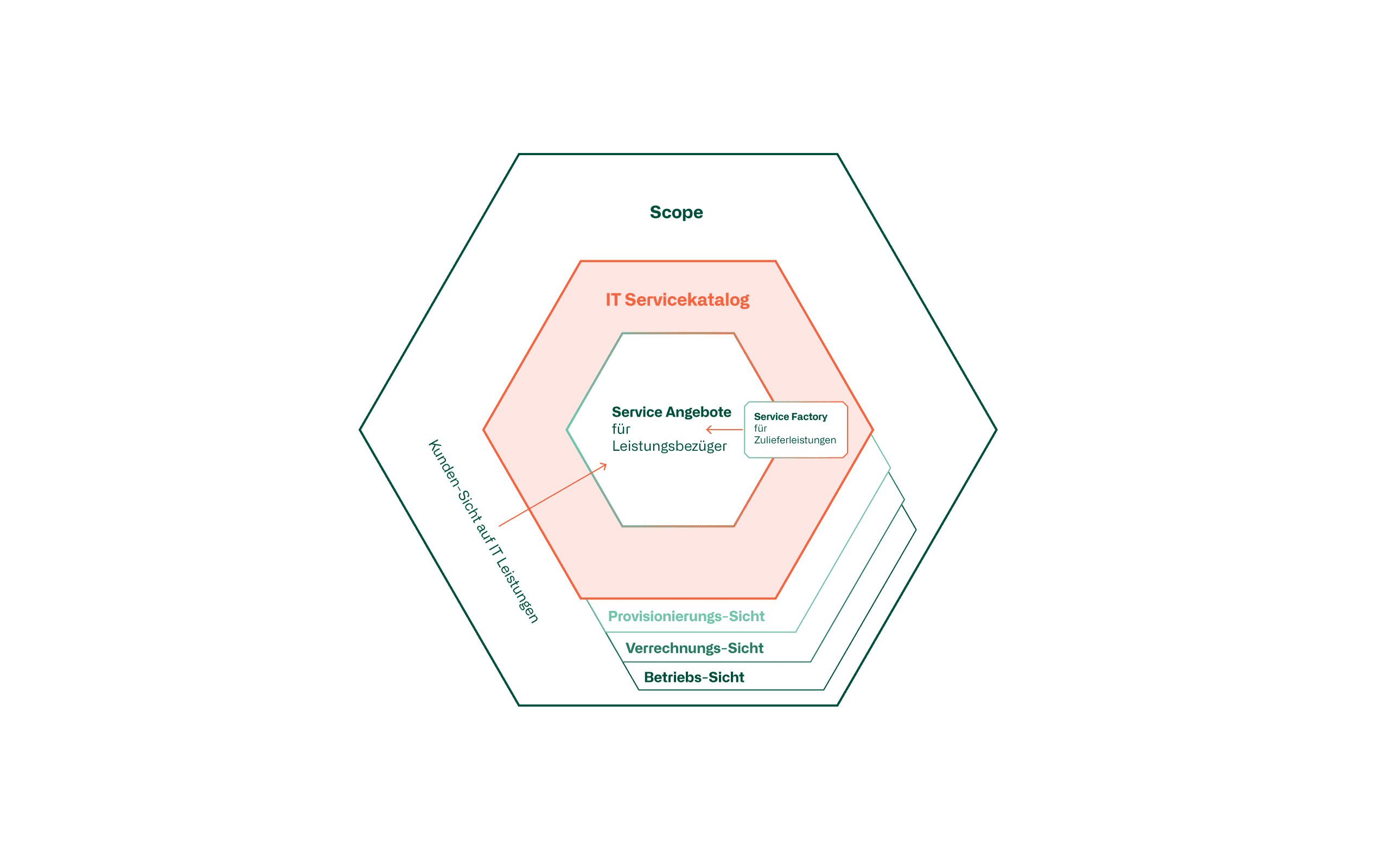
It should be taken into account that service delivery in the service-oriented environment has several dimensions, such as:
- Provisioning - An order triggers provisioning activities at one or more IT organisational units (responsibilities; who, what, when).
- Allocation of services - Every IT service generates costs for system use and services. Appropriate structures and procedures are needed to cover them through service charging.
- Operation/support - Every IT service requires corresponding operational activities; there are requirements for the service structure to ensure continuity or support in the event of faults.
Service organisation
With the introduction of a structured service catalogue, it is often necessary to adapt the organisation. The service moves to the centre and requires focused support and control. ITSM refers to this role as "service owner". By introducing such a role, the IT service is placed at the centre with an end-to-end view of service provision and operated accordingly. The technical "function and feature" consideration and decision thus loses importance.
What is a proven approach?
atrete understands the IT service catalogue as an essential basis for the service definitions in the IT organisation. A coordinated service offer supports constructive and successful cooperation with the service recipients. The service modules of the Service Factory determine the work assignments for the responsible IT teams and support efficient control of service provision. The cooperation and interactions between the IT teams are determined by the IT service structure.
The IT services in the service catalogue are each represented as a service MAP (tree structure). Each module is provided with additional information such as service description, responsible roles, valid OLA/UC, variants & options, costs, etc.. This promotes support and change efficiency, as all information on the service object can also be found with it.
We recommend starting with a pilot. In this pilot, 2-3 suitable IT services are to be selected from the company's portfolio, which are technically and operationally well documented. These IT services are to be modelled according to the requirements (decomposition). A suitable ITSM tool with catalogue mapping functions should be available for the subsequent mapping and documentation.
Successful introduction
The successful definition and introduction of IT service management in corporate IT is a matter for the boss and, from experience, usually also an organisational project. The introduction of a service end-2-end responsibility for IT services has an impact on the IT delivery organisation.
If a service catalogue is to be defined and built up in this way, it requires adequate ITSM tool support. Only through tool-supported use will the service catalogue bring its full benefits. Classical service desk tools usually understand a service catalogue as a keyword list without further object functionalities.
Conclusion
Creating a good IT service catalogue and keeping it up to date is certainly associated with effort. The added value for the entire company from the point of view of the purchaser and the service provider is immense. Just think of the ongoing discussions and dissatisfaction on both sides and the time spent on this. The most important argument is that the IT service becomes transparent, measurable and thus controllable on the basis of the service catalogue.
The satisfaction for the users and the IT team promotes motivation and creativity.
Today, IT is an important part of all business activities and the requirements and heterogeneity of the IT landscape are increasing. Active IT service management is an important basis for success with IT. Just like technology, this framework has to evolve continuously.
True to the principles: THINK BIG - act small
We help you to successfully implement your IT service management project. Our consultants have many years of expertise in the implementation of IT service management projects at various companies. We would be happy to share our experience from these projects with you to ensure the efficient and successful implementation of your IT service management projects. Corresponding certifications in ITIL 4 and project management, among others, reinforce our competences.
Agile Enterprise Architecture Management
This blog shows approaches for decision-makers who want to make their company fit for the future and secure a competitive advantage. We focus on how enterprise architecture management can be strengthened in an agile environment to fundamentally improve digitisation in the company.
Enterprise Architecture Management as an enabler for rapid innovation
Enterprise Architecture Management (EAM) is an important pillar for companies to implement the digital transformation. It describes the interaction of the company's business processes and IT technology at the highest management level.
The Enterprise Architecture (EA) is supported and shaped by the enterprise architects of the company and creates a holistic view of the different architecture areas:
- The business process architecture, which shows the business process modelling.
- The information and data architecture with its relationships, which are required for the execution of the business processes and are recorded in the data model.
- The application architecture (also called software architecture), which manages the applications for the execution of the business processes and their interfaces.
- The technology architecture, which defines the structure and operation of the IT infrastructure.
- It makes sense to complement these basic architectures with the security architecture and the operational architecture.
Figuratively speaking, enterprise architecture is not only the blueprint, but also the highway to the construction site of digitalisation. Integrating innovations into the existing corporate landscape is cheaper, simpler, less risky and, above all, faster. The prerequisite for this is a well-functioning EAM.
Challenges in an agile environment
Enterprise architects are tasked with ensuring structure, stability, standards, methods and compliance. Recognising new technologies and trends plays just as relevant a role as digital roadmaps, pace layering or big-picture perspectives. This is a challenging task in view of technological change and the ever faster spiral of innovation.
With the advent of Scrum, Kanban and DevOps and the many agile interdisciplinary teams, the challenge for enterprise architects to maintain an overview and fulfil their mandate is growing in order to avoid uncontrolled growth and isolated solutions. From their traditional role, enterprise architects are more used to acting in the background and intervening when a solution or architecture does not correspond to the enterprise architecture. As a result, they are often even perceived as preventing solutions from the project and development point of view. Projects develop solutions and are then shortly before or already in implementation and then have to pause or adapt them because they do not fit into the big picture. In the agile context, the danger of losing the overview of the individual teams and thus the overall view increases greatly and leads to additional work and loss of time.
Agile teams have the need to remain as lean and autonomous as possible in order not to lose momentum in a multi-layered web of dependencies of micro-services and spaghetti API structures. It is increasingly difficult for them to implement complex changes, as work has to be done on several components at the same time. As time goes on, cross-project solutions take a back seat and framework conditions are sometimes forgotten. In addition, solution architectures do not exist at the beginning in the agile environment; due to requirements, they are only developed later and iteratively in the project.
Proposed solutions in the agile environment
The key is therefore to be able to accompany and coach the complexity in the company. For this, the discipline of enterprise architecture must be understood as a link that connects the various changes. The enterprise architects support these changes by helping to minimise the dependencies and thus maintain the dynamics of the agile teams.
The enterprise architects must adapt to the agile approach in the projects and also be agile. In concrete terms, this means that they must actively and iteratively support the agile teams in the course of the project in order to develop a solution architecture. They also always act in terms of the big picture and contribute their know-how and solution proposals constructively. To this end, the enterprise architects must perform their task more communicatively, i.e. convey the message of the enterprise architecture more actively in the form of models, architecture principles, and make it more comprehensible and communicable.
Consequently, the enterprise architects are integrated into the projects and agile teams. For larger projects, it is advisable to create a technical solution board (with EA, system engineering, security, development) in addition to the technical solution board (technical committee) according to the same principle, in which solution proposals are jointly exchanged and decided. This exchange is important for mutual understanding and a constructive approach. For smaller projects, this can also happen within the framework of an overarching Technical Solution Board. Actually, this could also be controlled via the requirements, but the important interactive exchange on the architecture is often lost, as the product owner is usually purely technically oriented and focused on business value.
Ensuring IT efficiency and business value
An important principle is that all IT projects must add value in both dimensions (i.e. both business and IT). On the one hand, the projects must have a business benefit, i.e. fulfil a certain business case from the company's point of view, but on the other hand, the project must also increase IT efficiency (operational optimisation, development efficiency, easier integration, etc.). From the IT point of view, this avoids projects with technical debts that later end up in time-consuming and expensive clean-up operations.
To ensure that the further development of the IT landscape is continuously increased in terms of IT efficiency and business benefit, the coordination model of managed evolution (see figure) can be used.
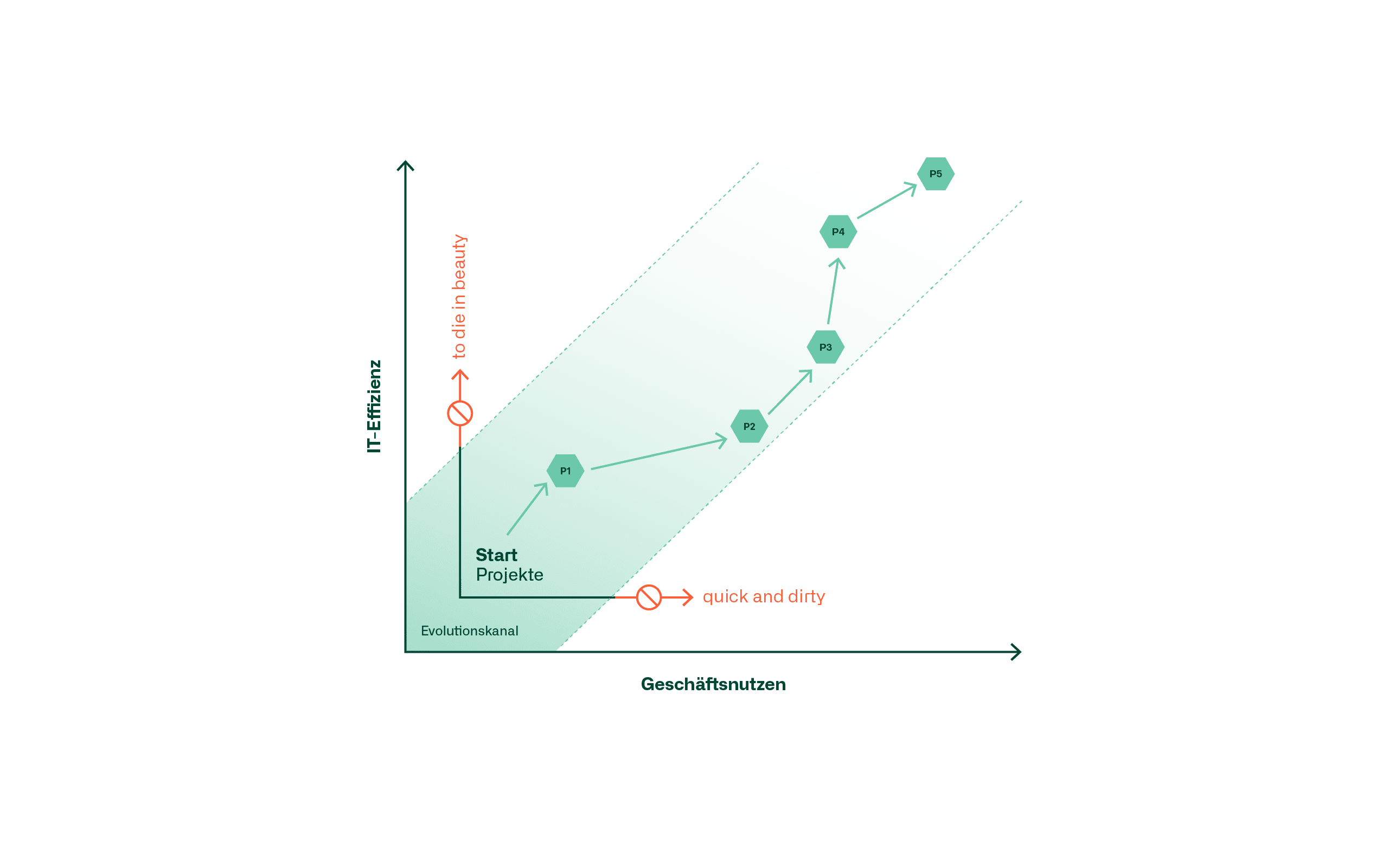
On the one hand, solutions that are too idealistic and therefore hardly realisable (to die in beauty) from the point of view of IT efficiency, which cause too high costs in implementation and thus ruin the business case, should be avoided. On the other hand, it is important to avoid solutions that are too pragmatic (quick and dirty), which promise a quick business benefit but are difficult to operate from an IT perspective or have to be replaced again shortly. The evolution channel should help to maintain a long-term balance between the two dimensions of IT efficiency and business benefit.
This is ensured in the project mandate by the projects. These must be able to demonstrate not only a business case, but also IT efficiency. The same applies to a technical solution board, which must argue in both dimensions.
Awaken the spirit of innovation in your company. As IT decision-makers, we are asked to align IT in such a way that it can implement solutions not only quickly but also cost-efficiently. As an independent consulting company with a lot of experience, we are happy to support you in setting the necessary cornerstones and driving forward the implementation.
SAFe and ITIL 4 - opposites or symbiosis?
In contrast to SAFe, ITIL Best Practices offers approaches that describe what needs to be done to achieve a successful IT operating model, but not how to implement it. To support the increasing business requirements for agility in IT value creation as well, ITIL 4 was republished at the end of 2019. ITIL has established itself in the IT environment over the last few years with varying degrees of success. But it is no longer possible to imagine life without it.
What actually is SAFe?
SAFe is a framework that enables companies to implement and scale comprehensive agile structures. SAFe is used to increase productivity and quality with an agile approach. The transparency gained, continuous successes and teamwork enable, among other things, an improvement in the employee environment.
SAFe is designed to help organisations maintain consistent and more efficient value creation on a regular and predictable schedule. It provides a knowledge base of proven, integrated principles and practices to support business agility.
IT Operation with SAFe
IT Service Management or IT Operation is not directly mentioned in SAFe. The whole topic of customer care, operation or support is embedded in SAFe in the whole organisation (methodology), respectively in the value streams.
The whole Value Stream concept is a critical element in SAFe and underlies the Lean Thinking principle. Identifying, visualising and optimising value streams is the primary method a lean company uses to reduce time to market while improving the timeliness, quality and value of its products and services. Each value stream represents the one sequence of steps the company needs to take to deliver value to the customer. These customers can be external as well as internal.
To build IT Operations, SAFe recommends the DevOps approach. DevOps teams can be embedded in the dedicated value streams and thus complete the IT operations tasks more efficiently.
However, if there is already an existing IT Service Management, for example according to ITIL, the company should not discard everything. Instead, the processes, services and organisation should be analysed and optimised in small steps. In this way, the company can always adapt to new circumstances and develop in the direction of agile service management.
In our experience, in some companies, for example, a distinction is made between plannable and non-plannable work. In a support environment, plannable work such as change management or problem management are good examples. Such tasks can be recorded in a backlog, prioritised and processed in sprints.
Non-scheduled work such as urgent customer requests, incidents, etc. usually have a high urgency and cannot be processed in sprints of e.g. 10 days. These non-plannable tasks could be prioritised and processed continuously as agile service management with a method (e.g. Kanban board).
To resume the DevOps thought, developers can divide the resources and work a percentage of their time in the agile teams in development and the other part in the agile teams working on the non-scheduled tasks.
A service desk as an entry gate for customer concerns, whether internal or external, will probably be indispensable in the future. However, a company can constantly analyse and optimise how these enquiries or incidents are handled afterwards.
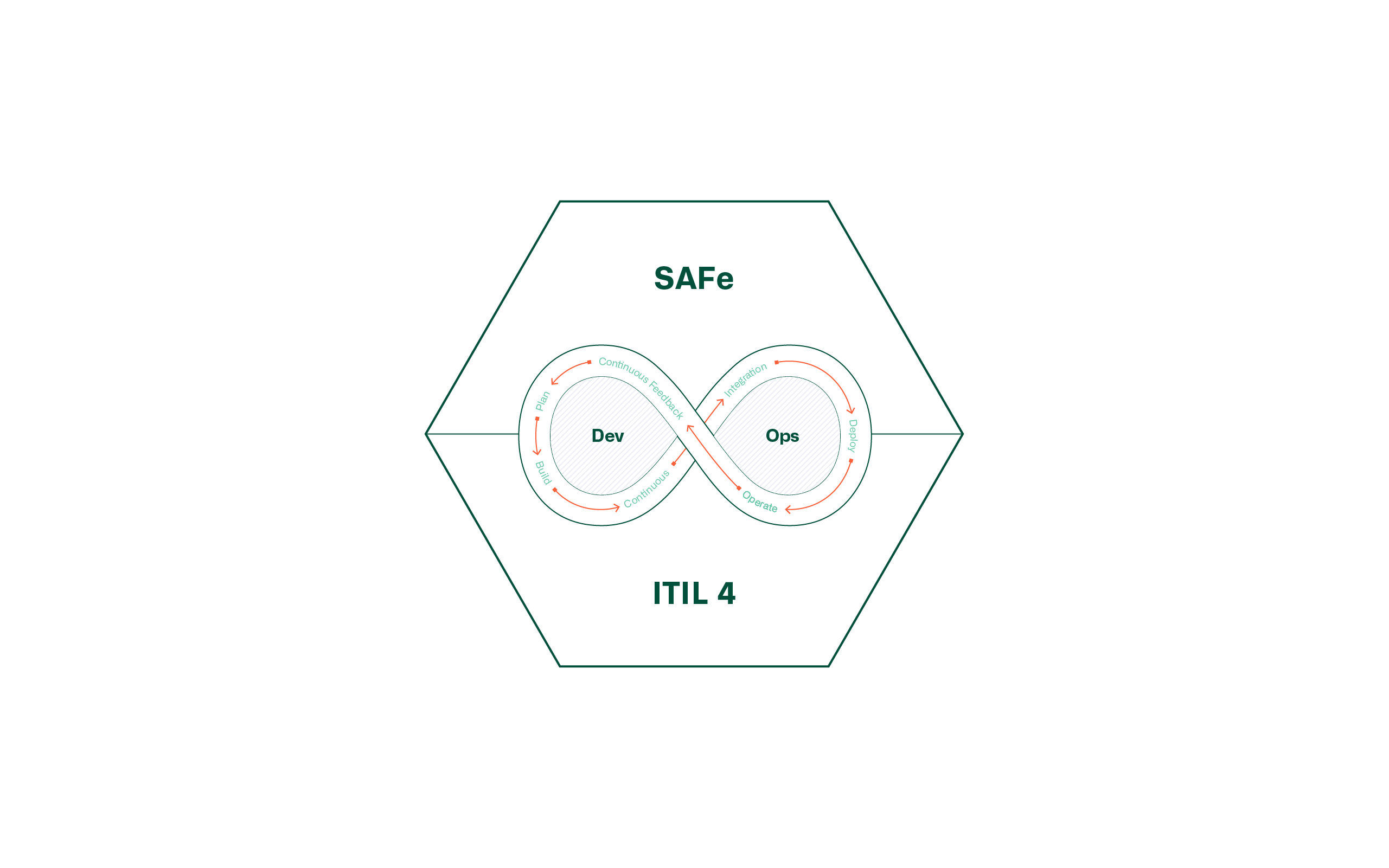
IT service management becomes agile
With the new ITIL 4 framework, the focus of consideration is placed on - value - costs - risks. The ITIL Value System now describes the chain of activities required to convert a business opportunity or service request into business value.
The Service Value System (SVS) replaces the previous management and life cycle view of IT services. The focus is now on the creation of business value by the IT organisation and its partners, which is referred to as the service value chain. The SVS describes the five key components of value creation and the relationships that exist between them.
Of the five key components, the Service Value Chain is the core element of the Service Value System (SVS) and consists of six generic activities that span the IT service lifecycle or value stream:
The guiding principles in the ITIL 4 framework are the seven guiding principles that ITIL practitioners can and should follow to drive value for their IT organisations. These guiding principles can play an important role in guiding IT decisions and helping IT managers to develop their own strategies and conclusions. The guiding principles are universal and enduring. Referencing is recommended when making decisions. They also belong printed large on the wall of every service manager and practitioner.
It is essential to understand service relationships - value co-creation, i.e. the co-creation of value within a service organisation.
Framework combination for value stream optimisation in IT operations
As described above, ITIL 4 has laid the foundation for applying IT service management in an agile business organisation. In fact, an agile framework is a prerequisite and SAFe, with its possibilities for cross-functional development, offers a way to implement the ITIL framework. Conversely, SAFe does not have precise definitions for an IT operating environment.
Involving the stakeholders from the beginning is a prerequisite. Traditional IT organisations still think in silos and primarily consider only their part of the value chain. The customer perspective was initially taken into account in the service definition, but was lost over time through various adjustments to the organisation and responsibilities. As a result, the individual delivery teams could only focus on themselves and their now incomplete mission. The service value starts with the customer and ends with him.
The DevOps approach in the SAFe framework provides the basis for organisational structures in relation to teams. The goal here is to assign the necessary decision-making powers to the teams by decentralising responsibility. The service value system definitions of ITIL 4 are used to control the structured procedure, taking into account the seven guiding principles and the practices. The aim is to generate value for IT services and products.
No company starts from scratch. It is strongly recommended to continue to use those definitions or practices that have proven themselves and incorporate them into value generation.
When introducing SAFe and/or ITIL 4, the company should definitely also consider which existing methods or frameworks have become established in the company and how these traditional methods are combined with the agile methods.
Another central element from classic IT service management is the service catalogue. The IT and supporting services described in it are valuable achievements and can be transferred into a product portfolio of the agile world. This is an important step towards harmonising the old and new IT service processing and improving and optimising value generation with the agile approach.
Conclusion
Many companies are currently facing or already in the process of such a transition to an agile environment. There are many unanswered questions about how and where to start, how exactly to understand the frameworks, and so on. As in the traditional world, there is no template that can be applied 1:1 to a company.
A practical and pragmatic implementation could look as follows:
We recommend analysing the services, processes, organisation and responsibilities in detail and creating a comprehensible overview. Work out the differentiation through dialogue with the stakeholders and, above all, the IT stakeholders and derive it into what is tried and tested and what is not. Experience has shown that a comprehensive product backlog can be derived from this and forms a qualified starting point.
Implementing agile transformation across the whole organisation at once often involves high risks. To reduce the risk, it would make sense to implement agile in small steps.
According to the agile principles: Start where you are and act iteratively and with feedback.
In order to successfully introduce the frameworks in the companies, we recommend the involvement of experienced coaches.
Our consultants have many years of expertise in the classic application of methods for your service management and project projects. This is continuously expanded with agile development and consolidated through practice. Our aim is to offer you as a customer maximum added value through our contributions and to manage and accompany your projects efficiently and professionally. Corresponding certifications in SAFe and ITIL 4, among others, underpin our competences.
atrete expands its CIO advisory team
Stephan Huber joined atrete on 04.01.2021 as a Senior Consultant. He has proven experience in IT service management and holds the ITIL 4 Managing Professional certification. Mr. Huber has worked for customers and service providers for the past 25 years. In various roles, he was responsible for the management and harmonization of IT operations organizations, service portfolio management as well as process and digitalization projects. Most recently, Mr. Huber was responsible for the operation of cyber security platforms at InfoGuard. He holds a degree in business informatics (HF).

Media contact:
at rete ag
Marlene Haberer
Phone: +41 44 266 55 83
Email: marlene.haberer@atrete.ch
atrete IT consultants continues to grow
The IT consulting company atrete strengthens its team in the areas CIO advisory with Sven Matheja and IT sourcing advisory with Rüdiger Vietze.


Sven Matheja has been working as a senior consultant at atrete since 01.11.2020. He has many years of experience in global product launches and project implementations in international companies. Prior to atrete, he worked for several years at General Electric as Product Manager in the Unified Communications division. He holds a university of applied sciences degree in International Management.
Rüdiger Vietze has been working as a senior consultant at atrete since 01.12.2020. He holds a university diploma in mathematics, a Certificate of Advanced Studies in process management, and numerous other certifications, including in project management. In the past ten years, Mr. Vietze has been active as an expert for public procurement, including unusual delivery objects, and as a project manager with a focus on school IT. As a generalist, he also has many years of diversified experience in business analysis and project management.
"We are delighted to further strengthen the CIO advisory and IT sourcing advisory divisions with the two new consultants to meet the increased demand from clients."
Michael Kaufmann, CEO and Managing Partner